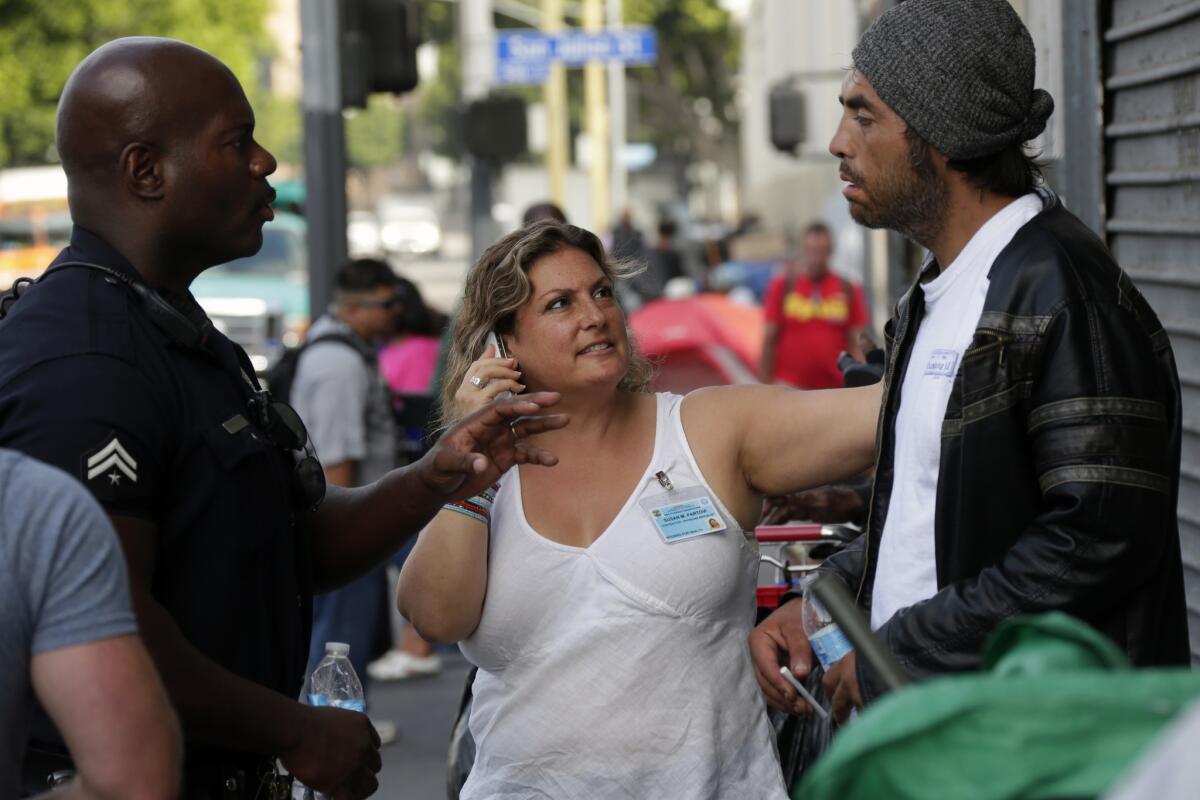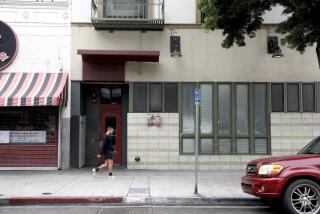Physician joins skid row cleanup to get homeless off the streets

- Share via
Armed with a stethoscope, Dr. Susan Partovi walked some of skid row’s meanest streets Wednesday, stopping to help a man dazed and stumbling down the sidewalk with blood caked on his head.
Luis Trejas, 40, said he’d been beaten up and asked for a cigarette. Partovi dropped her backpack, guided him down to the ground and took his blood pressure.
Partovi, the medical field director for the Los Angeles County Department of Health Services, was part of a team of mental health, social service and medical workers who joined an initiative to curb entrenched homelessness in the 50-block downtown Los Angeles district.
As city sanitation workers perform intensive cleanings, county social service providers go into the streets to get the estimated 1,700 people living there into medical care, rehab or other programs. Officials say the $3.7 million city-county program, called Operation Healthy Streets, will include bi-monthly and spot cleanings of streets and sidewalks.
The program was launched Aug. 4, when social, medical and mental health workers visited San Julian Street. The first cleanup took place Wednesday, and will continue through Aug. 21.
“The goal is to house up to 10,000 people” in the next five years, Partovi said during a briefing before the cleanup. “Some of these people are acutely ill.”
“We have coordination with the county, something we have rarely done in our approach to homelessness,” Los Angeles City Councilman Jose Huizar said. Huizar has also called for a homeless “czar” to over see the city’s initiatives.
Partovi was able to get paramedics to Trejas. But she and other team members will have more than violence and injury to overcome to fix skid row, where many homeless residents are skeptical about the new approach after decades of failed cleanup efforts.
“People want to get off the streets, they don’t want to go where they send them,” said a homeless man who gave his name as Philip. He said some of the shelters require attendance at religious services, while others demanded a sizable portion of people’s meager general relief check for rent.
“I been here five years, there ain’t no room in no shelters here,” said Omar Allah, 29, a Los Angeles native, sitting on a milk carton around the corner from San Julian, where he had been staying before the cleanup started. “You’ve got to go to jail to find out about housing.”
“That’s your real house, jail,” said his friend, Mike Johnson, 30.
Allah said he had been in transitional housing but left because of excessive regimentation and bad living conditions. He also said he had a psychiatric condition.
Partovi said the resistance to shelters and temporary housing is understandable. “They all want their own place,” she said. The county is developing permanent housing that includes mental health, substance abuse and medical care, she said.
Teams will also have to contend with early jail and patient releases that feed skid row’s population.
Michele Jones said St. Vincent’s Medical Center in Los Angeles discharged her in the middle of the night after back surgery, leaving her nowhere to go but skid row.
“I’ve tried to get into a place, nobody will help me,” said the Northridge native, 30, who still had an EKG electrode patch stuck to her chest.
St. Vincent spokeswoman Ann Betzsold said she could not comment on Jones’ statements.
Partovi said the county is opening two centers this year where patients can recuperate after hospitalizations.
During the cleanup, General Dogon, an organizer with the Los Angeles Community Action Network anti-poverty group, confronted Huizar, saying Operation Healthy Streets funds would be better spent on paying neighborhood residents who have been cleaning the streets on their own during years of official neglect.
Dogon also said the city was not doing enough. “People need resources on a daily basis,” he said.
But other new plans are afoot. The city and county, pushed by federal officials, are moving toward a “housing first” strategy that places people in apartments even if they have substance abuse or mental health issues.
Since 2008, L.A. County has committed to spending $118 million on 41 housing developments with a total of 2,066 residences, including 918 set aside for people who are mentally ill and homeless.
Partovi said her department also has set up an $18 million fund to subsidize rents for homeless people who cycle in and out of hospital care and emergency rooms.
Police are also easing enforcement of minor offenses, and instead teaming with social service providers to identify seriously ill people who need help.
The emphasis on housing the most vulnerable could leave out those caught in a short-term crisis, or who simply are young.
Jennifer Wilbon, 21, of New York City said she came to Long Beach for a gay pride festival but became stranded on skid row after she was robbed.
“It’s hard to find places that take young people in,” she said.
Times staff writer Irfan Khan contributed to this report.
Follow @geholland for news about skid row and homelessness.
More to Read
Sign up for Essential California
The most important California stories and recommendations in your inbox every morning.
You may occasionally receive promotional content from the Los Angeles Times.











